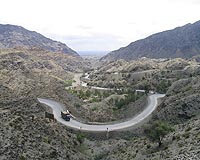| . |  |
. |
Boca Raton FL (SPX) Jul 03, 2009 Novel underwater laser networking and imaging technologies being developed by scientists at the Ocean Visibility and Optics Laboratory at Harbor Branch Oceanographic Institute at Florida Atlantic University may provide significant advantages over existing technologies in rapidly identifying and communicating potential threats in murky coastal waters. Harbor Branch has received $2 million from the U.S. Department of Defense, Office of Naval Research, to continue its cutting-edge research and development in the area of underwater laser sensing and robotics in an effort to develop next generation underwater sensing networks to enhance the security of coastal waters and ports, and to expand ecosystem monitoring capabilities. This project will build on current technologies and capabilities in laser imaging developed at Harbor Branch. When the technology is fully developed, it will be used onboard a group of small, co-operating underwater robots and will have extensive utility for future U.S. military operations including U.S. war fighters (intelligence, surveillance and reconnaissance, and mine countermeasures operations). Domestically, it will be used for Maritime security and environmental assessment to address some of the most critical areas in need of ocean research and technology development over the next ten years. The project is being developed in three phases, with the overall goal of investigating concepts in concurrent laser imaging and communications where dual-purpose imaging and communications system components are distributed within the co-operating group of underwater robots. Scientists at Harbor Branch will use advanced computer simulation software to predict the underwater laser light field in variable environmental conditions. Combined with measurements from their state-of-the-art underwater laser test facility which will be used as a proving ground for the techniques, the objective is to gain a thorough understanding of how such techniques can contribute to underwater imaging missions of the future. According to Dr. Fraser Dalgleish, principal investigator and assistant research professor at Harbor Branch, images of suspicious underwater objects need to be rapidly transmitted to a command center or to those who may be in danger. "Underwater mines pose a major threat to U.S. Navy, Coast Guard and merchant fleets," said Dalgleish. "Using intelligent, adaptive laser imaging and communication techniques with swarms of co-operating underwater robots could provide identification-quality underwater imagery in real-time across much greater regions of seabed than current technology allows, and will therefore be vital for effectively classifying both military and environmental threats to our coastal regions in the future." Share This Article With Planet Earth
Related Links Harbor Branch Oceanographic Institute Florida Atlantic University The Long War - Doctrine and Application
 Commentary: Waiting for al-Qaida's Godot
Commentary: Waiting for al-Qaida's GodotWashington (UPI) Jul 2, 2009 It's no longer a war on transnational terrorism? Before Dr. Emile Coue's method of psychotherapy, self-improvement based on the healing power of optimistic autosuggestion, becomes our national security comfort blanket, it would behoove us all to take a deep breath and snap out of creeping amnesia. By simply changing mental pictures, Coue figured the subconscious also changes -- as ... read more |
|
| The content herein, unless otherwise known to be public domain, are Copyright 1995-2009 - SpaceDaily. AFP and UPI Wire Stories are copyright Agence France-Presse and United Press International. ESA Portal Reports are copyright European Space Agency. All NASA sourced material is public domain. Additional copyrights may apply in whole or part to other bona fide parties. Advertising does not imply endorsement,agreement or approval of any opinions, statements or information provided by SpaceDaily on any Web page published or hosted by SpaceDaily. Privacy Statement |